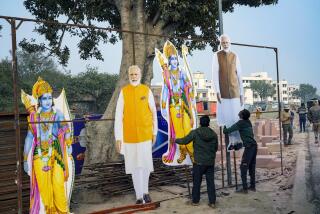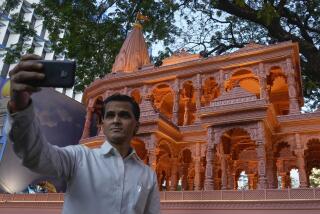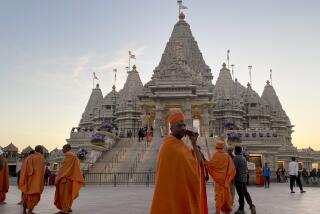Temple Marks Growing Hindu Presence
- Share via
MIDDLETOWN, Conn. — Hindu temples are as common in India as churches are in the United States, but Indian immigrants to New England in the 1970s often had to improvise a place to worship.
Many set aside a room at home, praying daily before photographs of their gods, and a handful of families took turns opening their homes for ceremonies, said Prema Manohar, an Indian who moved to Connecticut 21 years ago. But it was tough to maintain religious ties and to pass on to their children customs of the ancient religion.
That is changing with the completion of Sri Satyanarayana Temple. In a region better known for white-clapboard Protestant churches, the state’s first Hindu temple, citrus yellow and distinctly Art Deco in style, sits atop a hill in central Connecticut--a symbol of the nation’s growing religious diversity.
Completing the project and its 4,500-square-foot worship hall will require specialized workers and granite statues of deities--both imported from India. A consecration ceremony, originally planned for June, has been postponed by delays of both the workers and the statues, said Rao Singamsetti, president of the Connecticut Valley Hindu Temple Society.
The society has already obtained visas for eight temple architects who can build sanctums for the gods based on carvings described in ancient scriptures. The temple’s main deity will be Satyanarayana, a “true god” in Sanskrit, a statue expected to stand 6 feet tall and weigh 7 tons.
Statuary will also include two five-foot Hindu gods and seven smaller gods from various sects.
Until statues arrive from India, Connecticut’s worshipers can pray to smaller copper gods near the temple’s entrance.
The 5,000-year-old Hindu religious culture has a growing presence across the country--estimated at 227,000 Americans at the beginning of this decade. Nearly 100 temples have been built in recent years, with at least 24 states having a Hindu place of worship.
Middletown draws worshipers from nearby states, including Massachusetts, New Jersey and
New York, where many Hindu temples have a different main deity.
“The Hindu religion is a culture,” said Singamsetti, an economics professor at the University of Hartford. “There are variations of [main deities] like there are different cultures.”
Satyanarayana, the namesake deity in Middletown, is a gracious god who readily forgives. “We treat the god as we treat our best friend. We give food, worship with flowers,” Singamsetti said. “We make our wishes known to him and seek his help in fulfilling them.”
Depending on the occasion, Hindus pray to different gods, chanting mantras in Sanskrit to invoke the spirit of a god into his statue.
For many believers, the new temple means community and a way to pass on culture. “This is a gift,” said the society’s Singamsetti, “of the current generation to the future generation.”
“I think it’s good for our children,” added Manohar, recently preparing the cultural hall for a weekend event. “The temple is somewhere they can come together and learn.”
The project, funded by nearly $2 million in donations, is taking shape on 7.5 acres that the Connecticut Valley Hindu Temple Society bought in 1984.
More to Read
Sign up for Essential California
The most important California stories and recommendations in your inbox every morning.
You may occasionally receive promotional content from the Los Angeles Times.













